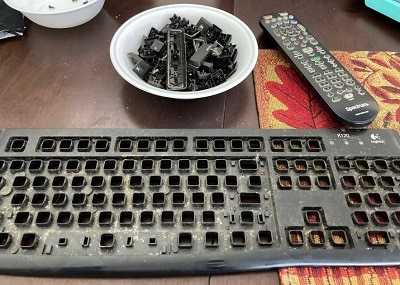I have a black Logitech keyboard. If you stand it on its end, it looks a little like the monolith from 2001: A Space Odyssey. Not quite the same dimensions, of course. The monolith is 1 by 4 by 9. My keyboard is .75 by 5.625 by 17.75. That’s almost twice as long, but it still reminds me of that iconic book and movie shape. And perhaps that’s exactly what the monolith is, or represents. In 3001: The Final Odyssey, Arthur C. Clarke reveals that it’s really a simple computer, even kind of stupid in some ways. Sounds like a keyboard to me, but without raised keys and pasted symbols. Like a clock without numbers, those ancients (“call them the Firstborn”) simply knew where to put their fingers. Either that, or the thing is a WiFi.
And why is it called a keyboard? That sounds like a plank of wood where you hang a bunch of keys on hooks. Why isn’t it called a button-board or a type-board? According to someone on Google, buttons are used to close an electrical connection, so electricians started calling them that because originally buttons were used to close garments? Makes sense.
Also in Googlish history, the reason the buttons on a keyboard and typewriter are called keys is because of the piano. But why are those long buttons called keys? Google doesn’t know. My theory is that in both cases, piano and typewriter, when you push a button it raises a long-stemmed thing that looks kind of like an old-fashioned key.
I haven’t looked up the origin of “type” because it’s late Thursday night and I have to send this to the newspaper by nine tomorrow morning. (That’s my schedule, not theirs, but I try to adhere to it.) However, I can make an arguable guess as to what happened way back then.
While Choe Yun-ui invented the moveable type in 1234 AD, he used carved wooden pieces. It wasn’t until 1439, when Johannes Gutenberg developed the method for quickly casting letters in metal, that books became popular throughout Europe and then the world. I can easily imagine a conversation in that workroom:
“What type of letters are you casting today?” Gutenberg asked.
“The L type,” the metallurgist said.
And thus it has always been that metal letters are called type.
So…what was it I meant to write about? Oh yeah.
Years ago I had a white keyboard, I don’t remember the brand. Once a year I took it apart to clean (my version of spring cleaning). I unscrewed the bottom, and the top frame came off, leaving the buttons attached to the rubber-coated circuit board. I had to pop those off with my finger and thumb. I put everything in the kitchen sink and filled it with hot, soapy water, and washed the frame with a scrub brush and the buttons with a toothbrush. And you know how that kind of plastic doesn’t allow drops and spots of water to dry very quickly, so even after twenty-four hours on a towel, I had to use an air can and Q-tips to finish drying everything. After the last cleaning, after pushing the buttons back on and attaching the frame, the A button and the spacebar always stopped working. Sometimes I’d push the A and it wouldn’t type, so I’d push it again and it would suddenly type a whole page of As, if I didn’t stop it. Same with the spacebar. So I bought my current keyboard, the monolithic Logitech.
I’m not sure how long I’ve had it, more than five years, I’m sure. The ridge on the F key is almost gone, and the one on the J key has completely vanished, so it’s been a while. When it was filthy enough (I didn’t clean it every spring) I decided to buy a wireless keyboard so I wouldn’t have to wash those 104 buttons. But my old HP didn’t like the new technology, and kept delaying my keystrokes. The same happened with the wireless mouse I bought (even with a new battery the old one was jerking slow). The wifi mouse would save left-clicks and suddenly display all the pages I was trying to get to, one after the other. I got a new hardline mouse and decided to wash my old keyboard for the first time.
I had to remove 16 tiny screws with a tiny Philips, and it turned out that the buttons are attached to the top. To remove those, I had to push each button out through the frame, and I put them in a bowl. After blowing compressed air across the bottom board, I washed the top in the sink. But this time I cleaned the buttons with Windex electronics spray on a cotton cloth. It still took a couple of hours, but I put my keyboard back together that night. It works and looks great! Even the buttons that have been worn shiny gives it a luster that a new keyboard doesn’t have.

